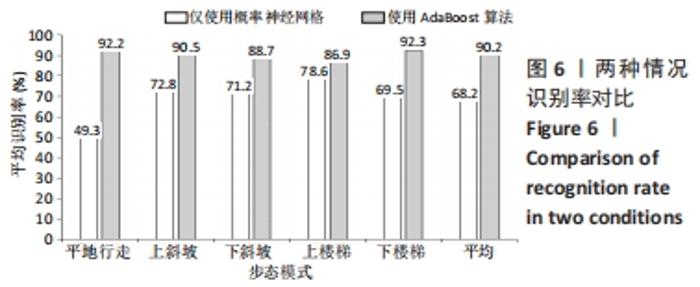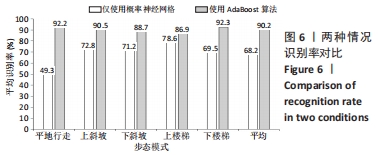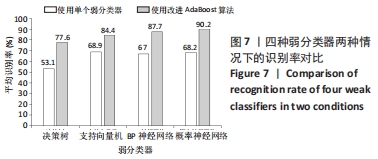[1] VU HTT, GOMEZ F, CHERELLE P, et al. ED-FNN: A New Deep Learning Algorithm to Detect Percentage of the Gait Cycle for Powered Prostheses. Sensors (Basel). 2018;18(7):2389.
[2] 孟琳,董洪涛,侯捷,等.面向下肢康复的柔性外骨骼机器人进展研究[J].仪器仪表学报,2021,42(6):1-13.
[3] JOO SY, LEE SY, CHO YS, et al. Clinical Utility of an Exoskeleton Robot Using 3-Dimensional Scanner Modeling in Burn Patient: A Case Report. J Burn Care Res. 2021 Apr 21:irab060. doi: 10.1093/jbcr/irab060. Online ahead of print.
[4] LANGHORNE P, BERNHARDT J, KWAKKEL G. Stroke rehabilitation. Lancet. 2011;377(9778):1693-1702.
[5] AHN KK, NGUYEN HTC. Intelligent switching control of a pneumatic muscle robot arm adopting learning vector quantization neural network. Mechatronics. 2007;17(4-5):255-262.
[6] LI Z, HUANG Z, HE W, et al. Adaptive impedance control for an upper limb robotic exoskeleton using biological signals. IEEE Trans Industr Electr. 2017;64(2):1664-1674.
[7] PHUKPATTARANONT P, THONGPANJA S, ANAM K, et al. Evaluation of feature extraction techniques and classifiers for finger movement recognition using surface electromyography signal. Med Biol Eng Comput. 2018;56(12):2259-2271.
[8] 陈玲玲,杨鹏,耿艳利,等.基于肌电信号的膝关节力矩识别方法[J].中南大学学报(自然科学版),2013,44(S2):117-121.
[9] 张燕,郜鑫,陈玲玲,等.基于随机森林算法的地形识别系统在主动型膝上假肢控制中的应用[J].中国组织工程研究,2015,19(53): 8609-8614.
[10] 王蒙,陈玲玲,耿艳利,等.基于有限状态机的智能下肢假肢控制[J].中国组织工程研究,2012,16(26):4756-4759.
[11] 龚思远,杨鹏,宋亮,等.基于迭代学习控制智能下肢假肢研制:实现了对健肢步速的跟随[J].中国组织工程研究与临床康复,2010, 14(13):2295-2298.
[12] PURUSHOTHAMAN G, VIKAS R. Identification of a feature selection based pattern recognition scheme for finger movement recognition from multichannel EMG signals. Australas Phys Eng Sci Med. 2018; 41(2):549-559.
[13] LONG Y, DU Z, CONG L, et al. Active disturbance rejection control based human gait tracking for lower extremity rehabilitation exoskeleton. ISA Trans. 2017;67:389-397.
[14] KRASOULIS A, KYRANOU I, ERDEN MS, et al. Improved prosthetic hand control with concurrent use of myoelectric and inertial measurements. J Neuroeng Rehabil. 2017;14(1):71.
[15] YANG DP, GU YK, LIU RQ, et al. Dexterous motion recognition for myoelectric control of multifunctional transradial prostheses. Adv Robotics. 2014;28(22):1533-1543.
[16] WU Y, JIANG D, LIU X, et al. A Human-Machine Interface Using Electrical Impedance Tomography for Hand Prosthesis Control. IEEE Trans Biomed Circuits Syst. 2018;12(6):1322-1333.
[17] GAO F, TIAN T, YAO T, et al. Human Gait Recognition Based on Multiple Feature Combination and Parameter Optimization Algorithms. Comput Intell Neurosci. 2021;2021:6693206.
[18] ANAM K, AL-JUMAILY A. Evaluation of extreme learning machine for classification of individual and combined finger movements using electromyography on amputees and non-amputees. Neural Netw. 2017;85:51-68.
[19] 周枚林.基于人体下肢肌电信号的复杂步态识别与步长估计研究[D].重庆:重庆大学,2019.
[20] 罗莎,夏国恩,朱新琰.改进Adaboost算法的人体步态识别方法[J].控制工程,2018,25(7):1312-1317.
[21] 郭欣,王蕾,宣伯凯,等.基于有监督Kohonen神经网络的步态识别[J].自动化学报,2017,43(3):430-438.
[22] STAGSTED RAW, RAMARI C, SKJERBAEK AG, et al. Lower extremity muscle power - A critical determinant of physical function in aging and multiple sclerosis. Exp Gerontol. 2021;150:111347.
[23] DING Z, YANG C, WANG Z, et al. Online Adaptive Prediction of Human Motion Intention Based on sEMG. Sensors (Basel). 2021;21(8):2882.
[24] 梁津国,罗二平,申广浩,等.基于自适应滤波器的表面肌电信号消噪方法研究[J].中国医学物理学杂志,2008(3):679-681.
[25] VALLERY H, BURGKART R, HARTMANN C, et al. Complementary limb motion estimation for the control of active knee prostheses. Biomed Tech (Berl). 2011;56(1):45-51.
[26] 郝静涵.基于SEMG信号及加速度信号的步态辨识研究[D].石家庄:河北工业大学,2019.
[27] 俞毕洪.基于表面肌电信号的穿戴式人体行为识别系统[D].杭州:浙江大学,2018.
[28] WANG W, SUN D. The improved AdaBoost algorithms for imbalanced data classification. Information Sciences. 2021;563:358-374.
[29] 于玲,吴铁军.集成学习:Boosting算法综述[J].模式识别与人工智能,2004,17(1):52-59.
[30] 徐继伟,杨云.集成学习方法:研究综述[J].云南大学学报(自然科学版),2018,40(6):1082-1092.
[31] 张松.基于SVM和Adaboost的多分类算法研究[D].济南:山东师范大学,2019.
[32] 杨新武,马壮,袁顺.基于弱分类器调整的多分类Adaboost算法[J].电子与信息学报,2016,38(2):373-380.
[33] PANG J, ZHAO Z. Real-time Monitoring of Fluidized Bed Agglomerating based on Improved Adaboost Algorithm. Journal of Physics Conference Series. 2021;1924(1):012026.
[34] TANG D. Fault Diagnosis Method of Power Transformer Based on Improved PNN. Journal of Physics Conference Series. 2021;1848(1) :012122.
[35] SHANMUGAM P, RAJA J, PITCHAI R. An automatic recognition of glaucoma in fundus images using deep learning and random forest classifier. Applied Soft Computing. 2021;109:107512.
[36] 方匡南,吴见彬,朱建平,等.随机森林方法研究综述[J].统计与信息论坛,2011,26(3):32-38.
[37] 李婉婉,李国宁.基于GMM聚类和PNN的道岔故障诊断研究[J].控制工程,2021,28(3):429-434.
[38] KIM J, WAGNER J, REHM M, et al. Bi-channel Sensor Fusion for Automatic Sign Language Recognition. Netherlands: 2008 8th IEEE International Conference on Automatic Face & Gesture Recognition. 2008:647-652.
[39] LI Y, CHEN X, ZHANG X, et al. A sign-component-based framework for Chinese sign language recognition using accelerometer and sEMG data. IEEE Trans Biomed Eng. 2012;59(10):2695-2704.
[40] 曹祥红,刘磊,杨鹏,等.利用多源信息和极限学习机的人体运动意图识别[J].传感技术学报,2017,30(8):1171-1177.
|





